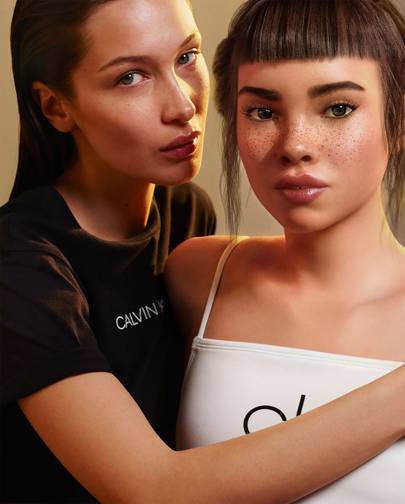The first major public-facing move from the leaderless label was its seasonal #MyCalvins campaign, featuring a roster of high-profile personalities, including Kendall Jenner, Billie Eilish and Shawn Mendes. The final instalment features Bella Hadid sharing a kiss with model avatar and CGI influencer Lil Miquela. The video and imagery were met with mixed reactions and Calvin Klein was subsequently accused of queerbaiting. Apologising to offended fans, the company said, “This specific campaign was created to challenge conventional norms and stereotypes in advertising… we explored the blurred lines between reality and imagination.”
“We understand and acknowledge how featuring someone who identifies as heterosexual in a same-sex kiss could be perceived as queerbaiting,” it continued. “As a company with a longstanding tradition of advocating for LGBTQ+ rights, it was certainly not our intention to misrepresent the LGBTQ+ community.”
The digital-first campaign is part of PVH Corp’s strategy to push Calvin Klein’s underwear and denim lines, which was outlined further in an internal memo shared by Marie Gulin-Merle, chief marketing officer, on May 17. To achieve the “halo effect” the company has previously outlined, Gulin-Merle announced the launch of a marketing group called InCKubator. The team of young, New York-based creatives will launch four to six consumer-specific initiatives each year to “challenge the status quo, push back and propose ideas that nobody has thought of,” said Gulin-Merle, according to Business of Fashion. “They know things that older executives do not know.” The InCKubator projects, which will encompass clothing, experiences and collaborations, will exist under a new Calvin Klein label that will be premiered in September.

There isn’t a pre-definition or preconceived recipe,” explained Gulin-Merle of the fluid nature of InCKubator, which will evolve in tune with customer feedback. “I think the brand is at its best when it connects with culture, and one of InCKubator’s functions is to connect with culture through these communities – not just culture at large, or what we think we know from 205 West 39th Street [Calvin Klein’s Manhattan headquarters].”
The InCKubator scheme has its own design team in place, but the brand is still looking for a creative director, whose role, Gulin-Merle explained, will be different to the one Simons undertook for two years. “There used to be a series of tactics that had become the thing: a show, a collection, some must-have items,” she said. “I’m not saying all this is going away, I’m saying that the new world we live in has offered brands a whole new palette… The old playbook has to be reinvented. We don’t want to use any of the old recipes.”
Although Gulin-Merle’s note signifies a new consumer-first mindset, after Simons’s high-fashion brand concept alienated Calvin Klein’s mass audience, the model is similar to that of fellow PVH-owned company Tommy Hilfiger. See-now, buy-now collaborations with Gigi Hadid and subsequently Zendaya encouraged the “halo effect” desired by Calvin Klein, whereby Tommy Hilfiger’s audience responded favourably to the products owing to the experiential launches and publicity surrounding them. After Calvin Klein’s punt to engage with a younger audience failed with Lil Miquela, who will InCKubator call upon to drive a new dawn?

No comments:
Post a Comment